Sustainability and Green Solutions in Smart Cities
Understand climate change and its urban impact

Learning Objectives
- Understand climate change and its urban impacts, including the urban heat island effect.
- Analyze how Smart City 3.0 integrates sustainability and citizen empowerment.
- Assess the environmental benefits of smart technologies such as IoT and AI.
- Examine practical green innovations like smart buildings, waste systems, and urban farming.
- Investigate strategies for climate resilience and compare urban and rural vulnerabilities.
5 min read
Course Overview
1. Green Buildings and Smart Energy Systems
2. Waste Management and Recycling Innovations
3. Water Conservation through Smart Systems
4. Urban Farming and Vertical Gardens
5. Climate Resilience Through Technology
6. Activity
7. Key Terms - Glossary
8. Quiz Questions
9. Links to external additional resources
10. Bibliography
INTRODUCTION
As cities expand, they face urgent challenges: rising emissions, limited resources, and unpredictable climate shifts. Smart Cities 3.0 aim to tackle these through innovation and collaboration. This module explores how sustainable practices, digital tools, and community involvement can make urban living greener, cleaner, and more resilient.
1. GREEN BUILDINGS & SMART ENERGY SYSTEMS
Efficient waste management is central to the success of a smart city. Modern systems integrate advanced technologies to streamline waste processing and recycling.
Technological advancements include:
- IoT-enabled bins: Equipped with sensors, these bins alert waste collection teams when full, optimizing pickup routes and reducing emissions.
- AI-powered recycling systems: These systems automatically sort waste, increasing recycling rates and lowering contamination levels.
- Portugal’s Valorsul Waste-to-Energy Plant: This facility converts urban waste into renewable energy, powering thousands of homes while reducing landfill dependency.
Research indicates that adopting smart waste management practices can reduce operational costs by up to 20% and increase recycling efficiency by 15% (European Commission, 2020).
2. WASTE MANAGEMENT & RECYCLING INNOVATIONS
Green buildings minimize environmental impact using smart designs, energy-efficient systems, and renewable energy sources. Key components include:
- Solar Energy Grids: Rooftop solar installations reduce fossil fuel reliance.
- Smart Energy Management: IoT-enabled systems track and optimize consumption.
- Passive Design: Buildings that use natural light and airflow to reduce energy demand.
In Porto, solar panels on public buildings like Casa da Música showcase renewable energy integration. Studies show green buildings can cut energy use by 30% and emissions by 35% (WorldGBC, 2021).
3. WATER CONSERVATION THROUGH SMART SYSTEMS
Water-smart cities conserve resources and improve infrastructure reliability. Methods include:
- Smart Meters: Track usage, detect leaks, and inform consumers.
- Rainwater Harvesting: Collect water for reuse in irrigation and sanitation.
- Greywater Recycling: Reuse lightly used water from sinks/showers.
Porto’s Águas do Porto initiative combines these technologies to reduce waste. UN data suggests smart systems cut water loss by 25% (UN, 2022).
4. URBAN FARMING & VERTICAL GARDENS
City farming addresses food security and reduces emissions. Sustainable practices include:
- Vertical Gardens: Plant-covered walls improve insulation and air quality.
- Rooftop Farms: Turn unused space into food sources.
- Hydroponics & Aquaponics: Grow produce with minimal water and space.
Porto’s Biodiversity Gardens show how urban farming enhances biodiversity and community well-being (FAO, 2021).
5. CLIMATE RESILIENCE THROUGH TECHNOLOGY
Smart cities use technology to prepare for climate risks. Key tools include:
- IoT Climate Sensors: Monitor weather and environmental data.
- Smart Drainage: Responsive infrastructure reduces flood risk.
- Predictive Analytics: AI models support proactive urban planning.
Porto’s Climate Action Plan features data-driven systems to manage flooding and heat stress (Climate Resilience Network, 2022).
Click here to download the full content!
ACTIVITY: SMART CITY SUSTAINABILITY PUZZLE
Objective: Design a sustainable smart city incorporating green energy, food production, water conservation, and waste reduction.
Instructions:
- Group Work – Teams of 3–5 create a city using a layout template.
- Design Tasks – Place key systems: solar/wind energy, smart bins, water tech, gardens.
- Present Models – Each group explains how their city addresses energy, food, water, and climate resilience.
- Reflection – Discuss trade-offs, innovation, and real-world applications.
Outcomes:
- Understand the role of integrated systems
- Practice collaboration and sustainability thinking
KEY TERMS - GLOSSARY
- Smart City 3.0: Citizen-driven model combining tech with inclusive planning.
- Green Building: Eco-friendly structure with efficient systems.
- Urban Heat Island (UHI): Higher urban temperatures due to dense infrastructure.
- Climate Resilience: City’s capacity to adapt to climate challenges.
- Vertical Farming: Growing plants in stacked layers for food sustainability.
QUIZZES
Quiz 1
Quiz 2
Quiz 3
LINKS TO EXTERNAL ADDITIONAL RESOURCES
- Estratégia Nacional de Smart Cities (Portugal) This strategy outlines Portugal’s national goals for developing smart cities, emphasizing sustainability, citizen-centered initiatives, and integrated urban management systems to achieve a low-carbon future. Estratégia Nacional de Smart Cities.
- Aveiro Tech City Aveiro Tech City is an initiative promoting technology-based solutions for urban challenges. Focused on mobility, sustainability, and education, it illustrates how local governments integrate smart solutions for environmental benefits. Aveiro Tech City.
- Portugal Makes Sense: Smart Cities This campaign highlights Portuguese contributions to smart city technologies, focusing on energy, mobility, and governance. It showcases innovative projects and their impact on sustainable urban living. Portugal Makes Sense: Smart Cities.
- Guimarães Smart City Initiative Recognized as one of Europe’s “100 Smart Cities,” Guimarães integrates smart solutions in energy, waste, water management, and urban mobility. The initiative aims to serve as a “Living Lab” for sustainable innovation. Learn more about Guimarães Smart City.
- Portugal Smart Cities Summit An annual event discussing innovations in smart city technology. It includes case studies from Portuguese cities like Lisbon and Porto, exploring themes like green buildings, water conservation, and energy management. Portugal Smart Cities Summit
BIBLIOGRAPHY
References (APA Style)
- Portugal Digital. (n.d.). Estratégia Nacional de Smart Cities. Retrieved November 15, 2024, from https://portugaldigital.gov.pt/estrategia-nacional-de-smart-cities.
- Aveiro Tech City. (n.d.). Home. Retrieved November 15, 2024, from https://aveirotechcity.pt/.
- Portugal Global. (n.d.). Smart Cities | Portugal Makes Sense. Retrieved November 15, 2024, from https://portugalmakessense.portugalglobal.pt/en/campaigns/smart-cities.
- Cidades Sustentáveis. (n.d.). Guimarães Smart City Initiative. Retrieved November 15, 2024, from https://www.cidadessustentaveis.pt/.
- Smart Planet. (2024). Portugal Smart Cities Summit. Retrieved November 15, 2024, from Smart Planet | Cities, Buildings, Spaces
European Commission. (2020). The future of smart waste management: A guide to innovations and technologies. Retrieved from https://ec.europa.eu/environment
Food and Agriculture Organization (FAO). (2021). Urban farming for sustainable cities. Retrieved from https://www.fao.org/urban-agriculture
United Nations. (2022). The role of technology in urban water conservation. Retrieved from https://unwater.org
World Green Building Council. (2021). Benefits of green buildings: Energy and emissions reductions. Retrieved from https://worldgbc.org
Climate Resilience Network. (2022). Smart cities and climate adaptation strategies. Retrieved from https://climateresilience.org
Accessibility tools

